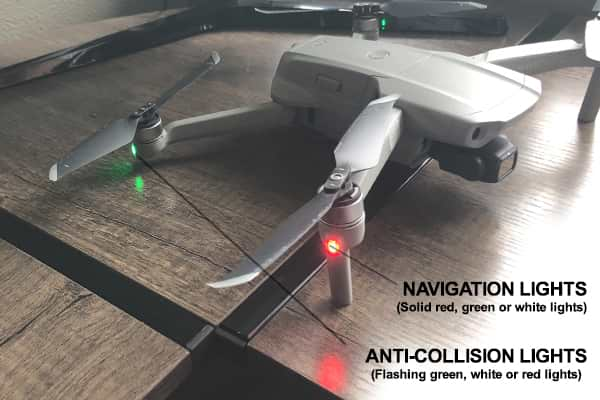
Have you ever seen some weird red and green blinking lights in the night sky and wondered if they were stars or drones? Well, you’re not alone! I did some research on what drones look like at night, and this is what I discovered.
Almost all hobby drones have lights to some degree. These lights can be seen at night as solid white, green, or red lights. Or they can be seen as blinking/strobe white, green, or red LEDs. They are hardly visible during the day, however, at night time, they can be seen from a mile away.
If you’re wondering what these lights look like at night, and what they are for, keep reading!
Types Of Drone Lights And What They Look Like At Night
Drones can have two types of lighting systems. These lights are:
01. Navigation Lights. These lights are usually solid lights which means they do not blink or strobe. They can be seen as a white, green, or red color which is what most people see coming from a drone at night as well as during the day.
02. Anti-Collision Lights. These lights are usually blinking or can be seen as a strobe. The color of these lights is usually green, white, or red.
You are able to utilize both anti-collision lights and navigation lights on a drone so there is no need to choose between the two, but it’s still interesting to know the difference.
A few years ago, anti-collision lights were a far stretch from a standard addition to your drone. However, these days they are very common. In fact, some companies have taken the liberty of creating drone lighting systems that allow you to switch between different regularities of light, giving your drone a personalized edge. Nice!
These options allow pilots to choose whether they want to use a certain light for anti-collision or navigation, making it easier for them to identify what is happening.
While all this may sound cool, you’re probably wondering exactly how necessary these lights are. In other words, are drones legally required to have lights?
Are Drones Required to Have Lights?
The FAA (Federal Aviation Administration,) is an agency in the United States Department of Transportation and they oversee civil aviation within the United States of America.
So what does the FAA say about drone lights? Do you have to have them or not?
The FAA has different lighting requirements that enthusiasts need to follow for different times of the day. So depending on the time of day will depend on what law applies to you. Here’s the lowdown:
Daylight. This is defined as 30 minutes before official sunrise to 30 minutes after the official sunset in your local area. Anti-collision lighting is not required during daylight. The FAA has no specific light requirements for flights that are made during daylight.
Morning and Evening Civil Twilight. Morning civil twilight is usually defined as starting an hour before sunrise and ends half an hour before sunrise. Evening civil twilight is usually defined as starting half an hour after sunset and ends an hour after sunset. Drone flights that are made during twilight do require anti-collision lighting.
Night. This is usually described as the time between the end of evening civil twilight and the beginning of morning civil twilight. Any flight made during this time(night time) with a drone is required by the FAA to have anti-collision lighting.
There is still some confusion, however, when it comes to the use of anti-collision lights. Because of this, I recommend being cautious at all times with the use of drone anti-collision lights.
You should use them at any time when you think they could help other pilots see your aircraft, even during a cloudy day. It is always better to be safe than sorry.
Why Do Drones Have Anti-Collision Lights?
If you are about to set off on your first night flight with your drone, you might be wondering why you would need anti-collision lights on your drone when your drone already has navigation lights?
Well, there are a few key reasons why you would need to attach these lights to your drone before you fly your drone at night. Let’s take a look:
Helping you. The drone anti-collision lighting helps you see the drone better at night. Your drone might have built-in drone lights, but these lights are almost non-existent during the day and are also not very visible at night. Anti-collision lights are bright and they make it a lot easier for pilots to spot their drones at night.
Helping others. Anti-collision drone lights are also a big help for anyone that might be nearby you at the time so they can also spot your drone in the sky. Whether they are a civilian, authorities, or another pilot, they need to be able to see your drone at night too.
Safety. One thing you need to remember is that it is very dark at night and once your drone gets a few hundred feet in the air it is going to be a lot harder to see it.
If you happen to lose sight of your drone, the repercussions could be disastrous! Your drone could end up crashing and badly damaged, or worse, you could really hurt someone.
FAA regulations. The FAA requires that all pilots flying at night needs to attach anti-collision lights to their drone. It does not matter if you are flying for recreation or commercially, these lights need to be attached.
They also require that the lights need to be visible from 3 statute miles or greater which means that there’s a good chance your small built-in drone lights will not cut it.
It is also better to not take any chances with these rules and regulations made by the FAA because if the authorities catch you, they could confiscate your drone or worse.
Tips And Tricks For Anti-Collision Lighting on Your Drone
You might be wanting to add some lights to your drone and set out on a nighttime aerial shoot with your drone. However, before you go and buy anti-collision lights, here are a few tips and tricks that might help you decide what lights to buy and how to best utilize them:
The number of lights. The first thing you need to consider is how many lights you are going to need. The reason for this is that some drones are shaped differently and thus you might need at least two lights to get full coverage and to make sure the light is spread out evenly.
Direction. You need to decide if you want the light on the drone to be fully spread out or focused on a specific direction before you buy.
A lot of companies that sell lights for drones only focus on one thing at a time, which can be a problem when flying at night. It is better to have the light spread out as much as possible.
Type of light. I suggest that you consider buying drone lights that can switch from a solid-state to a strobe. That way you can have both navigation lights as well as anti-collision lights at a press of a button. This is also great in case of light failure. If one light fails you can exchange it with another one easily.
Weather. What kind of weather you are flying in is important when choosing lights. While flying you might get caught in the rain and your drone might be able to handle it while you bring it back in, but your lights might not be able to. Another thing is, you need good lights if you are going to be flying in the fog.
Battery. How they are powered is very important. Some of these lights draw power from the battery, which means you need to consider your flight time.
Some use portable LiPo batteries that can be recharged. I personally prefer these as they are LEDs which means they last longer and the fact that they can be recharged after a while is a bonus. They also don’t affect the battery life of my drone.
